5.7 Comparing modulation schemes
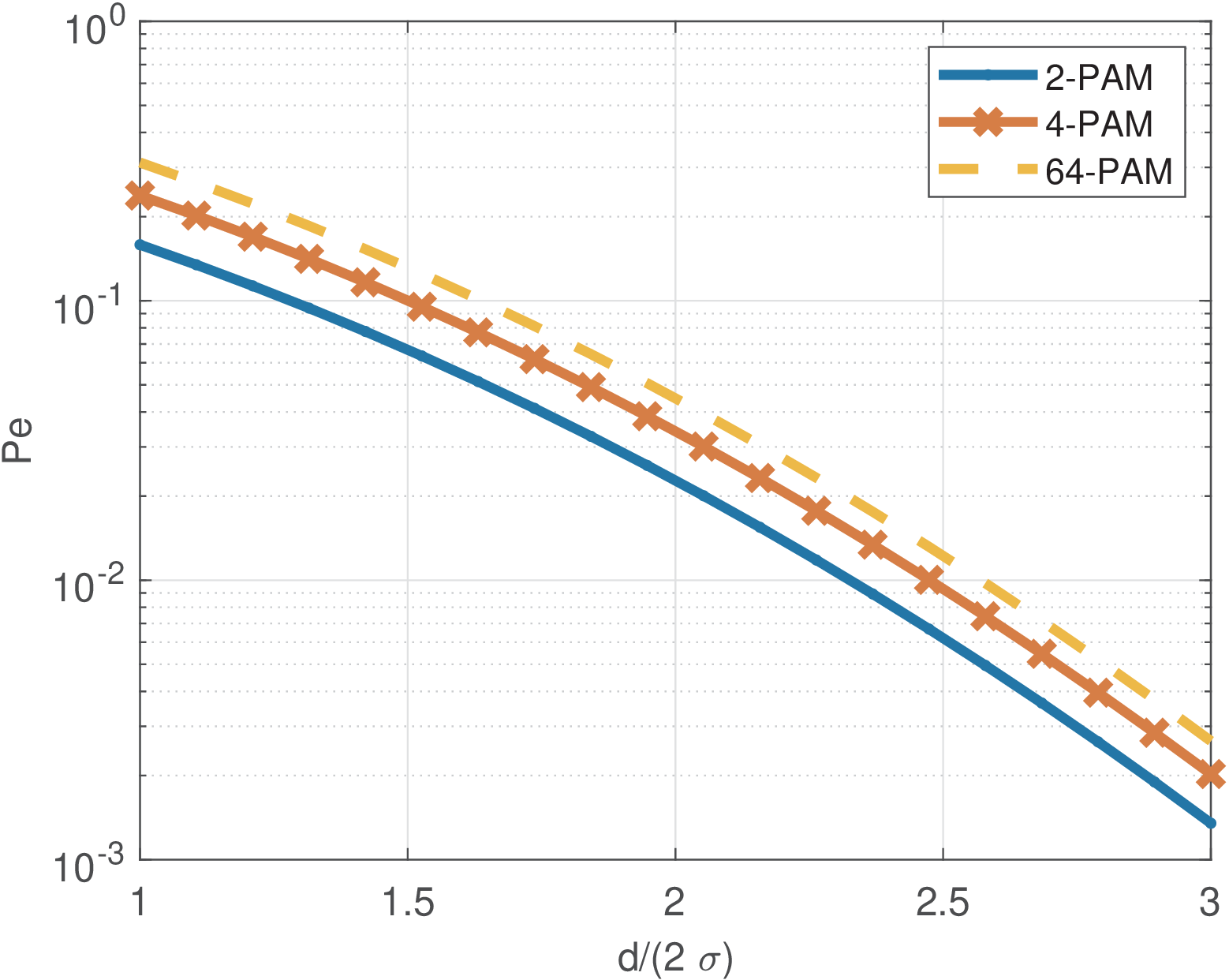
It is possible to compare different PAM systems using Eq. (5.6). Figure 5.11 informs for PAMs with and 64. For a given , is larger when increases.
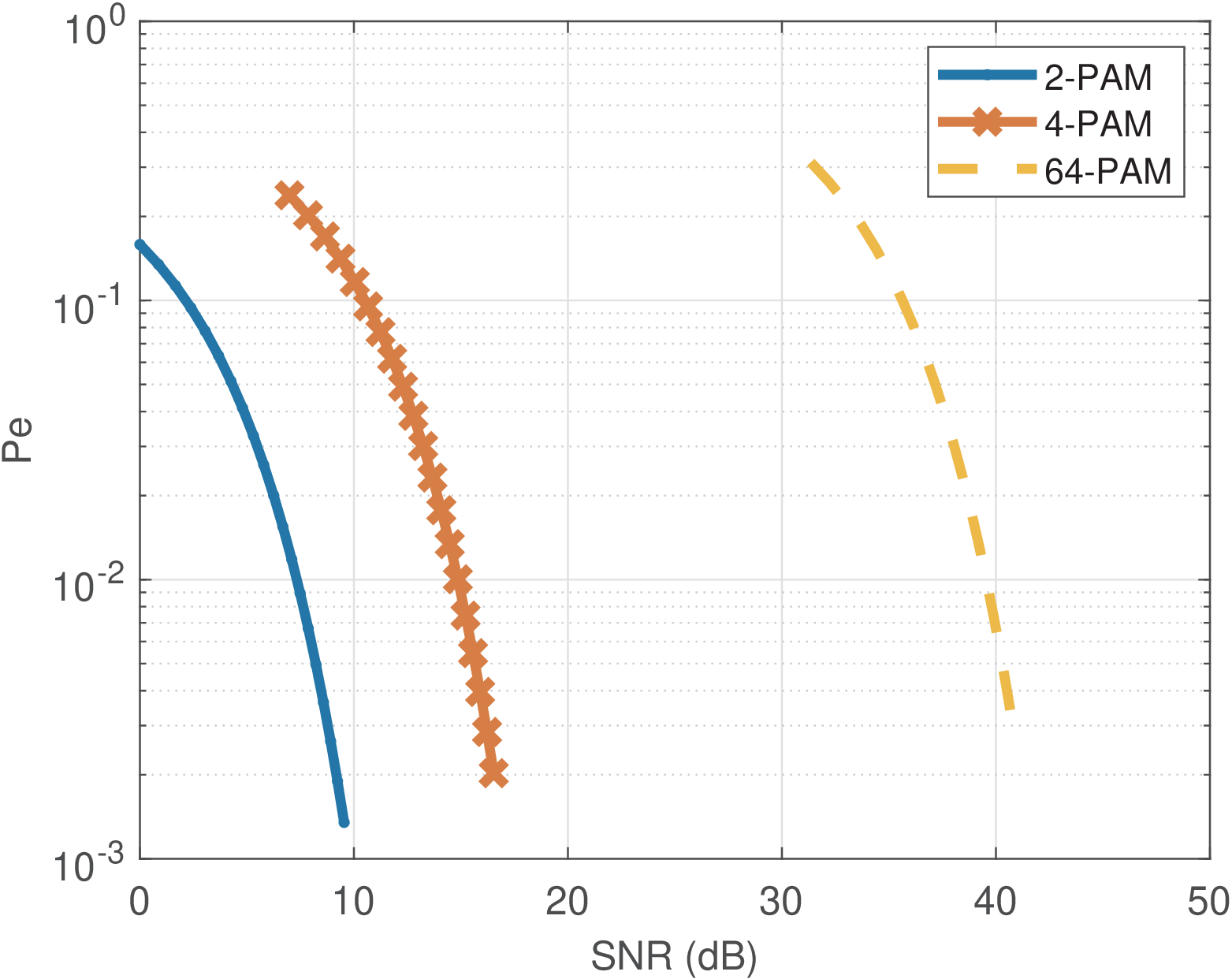
Note that, when is the same for different , the transmitted power increases with because the constellation expands while the distances between neighboring symbols is held fixed. This implies that, for a given , a larger SNR is required when increases. This fact is illustrated in Figure 5.12, which is a modified version of Figure 5.11 that uses the SNR in the abscissa. For example, to obtain the 2-PAM, 4-PAM and 64-PAM require approximately 7, 15 and 40 dB of SNR, respectively.
One should be careful when using graphs as Figure 5.12 to compare distinct modulation schemes. There are important figures of merit in digital communications that are not taken into account in Figure 5.12 such as the bit rate and required bandwidth BW. Therefore, it is convenient to normalize the SNR as follows:
which is equivalent to
|
| (5.14) |
For example, assuming kbps and kHz, an dB in linear scale is approximately 25.12 and corresponds to an , which corresponds to approximately 11 dB.
Hence, the quantity can be interpreted as a normalized SNR. The BW in Eq. (5.14) is not (necessarily) the signal BW, but the BW at the receiver input.3 When using this equation, one may not use the BW of e. g. a shaping pulse (e. g., the value of when using raised cosines). In fact, in the case of discrete-time signals, , which corresponds to the whole bandwidth. When performing a symbol-based simulation, , such that
|
| (5.15) |
or, equivalently, .
For example, for a polar binary PAM signal with symbols () and assuming the shaping pulse has unitary energy, i. e., , then . With the AWGN variance and using Eq. (5.9), can be written as
Note that, in this case (), as indicated by Eq. (5.15).
It is useful to observe that can be estimated as the total energy of a signal divided by the number of bits in the signal. Assuming is the equivalent energy in Joules of a discrete-time signal with samples, Eq. (E.21) and leads to
where is the equivalent signal power in Watts (see Section C.12.5).
For discrete-time signals sampled at , recall that the filtered WGN has variance
because .
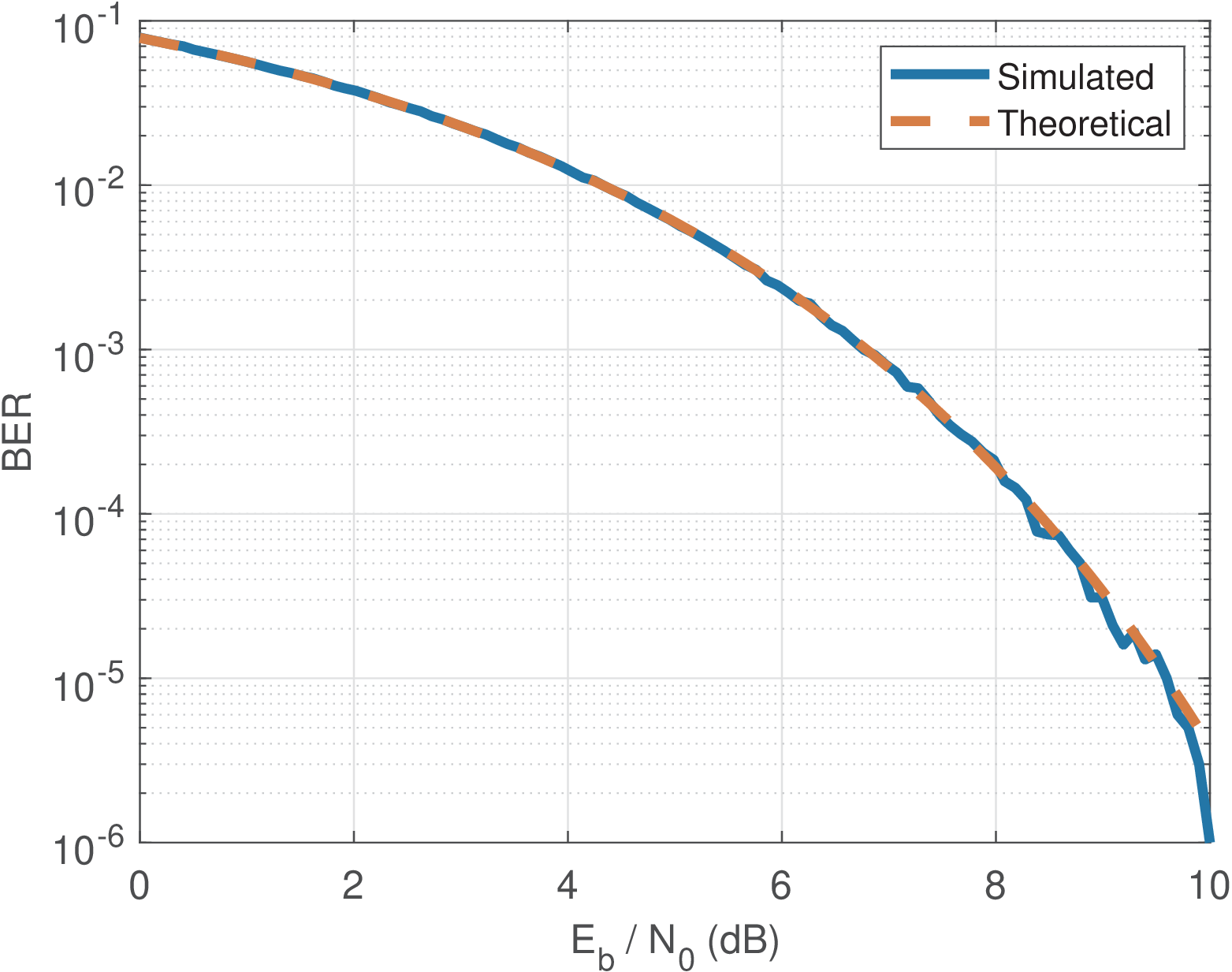
Figure 5.13 was generated with code Listing 5.4, which uses and is similar to Listing 5.3, which uses SNR. When both and are in dB, the difference is 3 dB as indicated by Eq. (5.15). Listing 5.4 adopted a larger number of transmitted bits because achieved values smaller than .
1%Perform a symbol-based simulation for binary PAM / PSK 2d=20; %Distance between symbols 3A=d/2; %Amplitude A=d/2 Volts 4R = 200; %rate in bps 5Fs = R; %sampling rate in Hz 6Nbits = 1e6; %Number of transmitted bits 7bits = rand(1,Nbits)>0.5; %bits (0 or 1) 8symbols = A*2*(bits-0.5); %symbols (-A or A) 9ebN0_dB = linspace(0,10,100); %Eb/N0 in dB 10ebN0 = 10 .^ (0.1*ebN0_dB); %linear Eb/N0 11Eb = A^2/R; %energy per bit, or Eb=mean(symbols.^2)/R 12N0 = Eb ./ ebN0; %one-sided AWGN PSD 13noisePower = N0*Fs/2; %noise power (sigma^2) 14V=length(noisePower); %number of points in grid 15ber = zeros(1,V); %pre-allocate space 16for i=1:V 17 %generate noise 18 noise = sqrt(noisePower(i)) * randn(size(symbols)); 19 receivedSymbols = symbols + noise; %AWGN 20 %recover bits using ML threshold equal to 0 21 decodedBits = receivedSymbols > 0; 22 ber(i) = sum(decodedBits ~= bits)/Nbits; %estimate BER 23end 24%compare with theoretical expression: 25theoreticalBER = ak_qfunc(sqrt(2*ebN0)); 26clf,semilogy(ebN0_dB,ber,ebN0_dB,theoreticalBER,'--'); 27xlabel('E_b / N_0 (dB)'); ylabel('BER'); grid; 28legend('Simulated','Theoretical');
Listing 5.5 compares the Monte Carlo simulation of 16-QAM with the theoretical expression for .
1%Perform a symbol-based simulation for square M-QAM 2M=16; 3snr_dB = linspace(0,16,100); %SNR in dB 4const=ak_qamSquareConstellation(M); %constellation 5Nsymbols=1e7; %number of symbols 6txIndices = floor(M*rand(1,Nsymbols)); %0 to M-1 7symbols = const(txIndices+1); %transmitted symbols 8snr = 10 .^ (0.1*snr_dB); %linear SNR 9signalPower = mean(abs(symbols).^2); %must use abs() 10%noisePower is the noise power "per dimension". For QAM 11%N=2 dimensions and the total noise power is 2*noisePower 12noisePower=(signalPower ./ snr)/2; %noise power (sigma^2) 13V=length(noisePower); %number of points in grid 14ser = zeros(1,V); %pre-allocate space 15for i=1:V 16 %complex noise 17 noise = sqrt(noisePower(i)) * randn(size(symbols))+... 18 j * sqrt(noisePower(i)) * randn(size(symbols)); 19 receivedSymbols = symbols + noise; %AWGN 20 decodedSymbolIndices=ak_qamdemod(receivedSymbols,M); 21 %estimate SER 22 ser(i)=sum(decodedSymbolIndices~=txIndices)/Nsymbols; 23end 24%compare with theoretical expression: 25qvalues = ak_qfunc(sqrt(3*snr/(M-1))); 26temp = (1-1/sqrt(M))*qvalues; 27theoreticalSER = 4*(temp - temp.^2); 28clf, semilogy(snr_dB,ser,snr_dB,theoreticalSER,'--'); 29xlabel('SNR (dB)'); ylabel('SER'); grid; 30legend('Simulated','Theoretical');
Listing 5.6 consists of a version of Listing 5.5 using instead of SNR. Note that for consistency, the SNR range used in both was the same.
1%Perform a symbol-based simulation for square M-QAM 2M=16; %number of symbols 3ebN0_dB = linspace(0,14,20); %SNR in dB 4Nsymbols=1e5; %number of symbols 5b=log2(M); %number of bits per symbol 6const=ak_qamSquareConstellation(M); %constellation 7Rsym = 400; %symbol rate (bauds) 8R = Rsym*b; %rate in bps 9Fs = Rsym; %sampling rate in Hz 10Nbits = Nsymbols*log2(M); %Number of transmitted bits 11txIndices = floor(M*rand(1,Nsymbols)); %0 to M-1 12symbols = const(txIndices+1); 13ebN0 = 10 .^ (0.1*ebN0_dB); %linear Eb/N0 14snr = ebN0 * R / Fs; %linear SNR 15Eb=mean(abs(symbols).^2)/R; %energy per bit, note abs(.) 16N0 = Eb ./ ebN0; %one-sided AWGN PSD 17%noisePower is the noise power "per dimension". For QAM 18%N=2 dimensions and the total noise power is 2*noisePower 19noisePower = (N0*Fs)/2; %noise power (sigma^2) 20V=length(noisePower); %number of points in grid 21ser = zeros(1,V); %pre-allocate space 22for i=1:V 23 %generate complex noise 24 noise = sqrt(noisePower(i)) * randn(size(symbols))+... 25 j * sqrt(noisePower(i)) * randn(size(symbols)); 26 %AWGN 27 receivedSymbols = symbols + noise; 28 decodedSymbolIndices=ak_qamdemod(receivedSymbols,M); 29 %estimate SER 30 ser(i)=sum(decodedSymbolIndices~=txIndices)/Nsymbols; 31end 32%compare with theoretical expression: 33qvalues = ak_qfunc(sqrt(3*snr/(M-1))); 34temp = (1-1/sqrt(M))*qvalues; 35theoreticalSER = 4*(temp - temp.^2); 36clf,semilogy(ebN0_dB,ser,'x',ebN0_dB,theoreticalSER,'--'); 37xlabel('E_b / N_0 (dB)'); ylabel('SER'); grid; 38 39%using Matlab: 40[berm, serm] = berawgn(ebN0_dB, 'QAM', M); 41hold on 42semilogy(ebN0_dB,serm,'or'); 43 44legend('Simulated','Theoretical','Matlab theo');
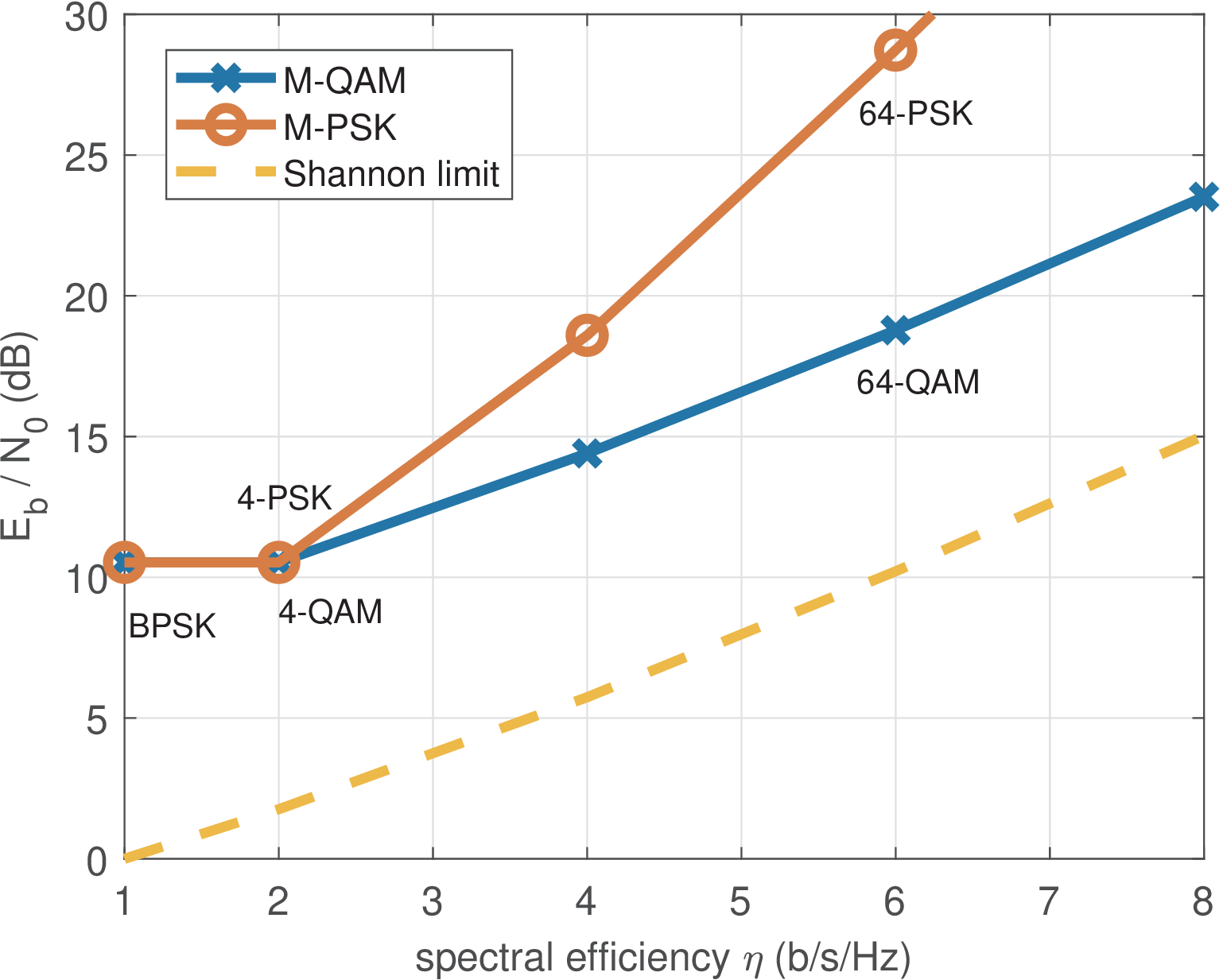
Instead of using , it is sometimes more interesting to use for comparing different modulation schemes. Because analytically calculating is sometimes unfeasible, it is commonly assumed that Gray coding is used and , i. e., each symbol error leads to only one bit error. Under this assumption, the following two approximations can be used:
and
for M-QAM and M-PSK, respectively. These expressions inform the amount of power required to reach a given . It is useful to use the spectral efficiency and observe the bandwidth requirement. For a QAM
|
| (5.16) |
because a QAM over a (bandpass) channel of bandwidth , can use for zero ISI when assuming zero excess bandwidth.
Hence, using Eq. (5.16), which is also valid for M-PSK, Listing 5.7 makes this comparison, which results in Figure 5.14.
1Pb=1e-6; %target bit error probability 2b=2:2:8; %range of bits per symbol 3M=2.^b; %number of symbols 4qarg = Pb*b./(4*(1-1./sqrt(M))); %argument of Q^{-1} 5gap = 1/3 * ak_qfuncinv(qarg).^2; %gap to capacity 6EbN0_qam = gap .* (2.^b -1) ./ b; %for QAM 7EbN0_psk = (ak_qfuncinv(qarg).^2)./(2*b.*(sin(pi./M)).^2); 8EbN0_qam_dB = 10*log10(EbN0_qam); %in dB 9EbN0_psk_dB = 10*log10(EbN0_psk); %in dB 10EbN0_binary = 10*log10((ak_qfuncinv(Pb)^2)/2); %for BPSK 11b=[1 b]; %pre-append the result for BPSK (or binary PAM) 12EbN0_psk_dB = [EbN0_binary EbN0_psk_dB]; 13EbN0_qam_dB = [EbN0_binary EbN0_qam_dB]; 14EbN0_shannon_dB = 10*log10((2.^b -1) ./ b); %Shannon limit 15plot(b,EbN0_qam_dB,b,EbN0_psk_dB,b,EbN0_shannon_dB);
Figure 5.14 shows that, as the spectral efficiency increases, the gap between the PSK performance and the Shannon limit becomes larger. In contrast, this gap remains approximately constant for QAM. When and 8, the QAM gaps are approximately 8.77 and 8.48 dB, respectively.
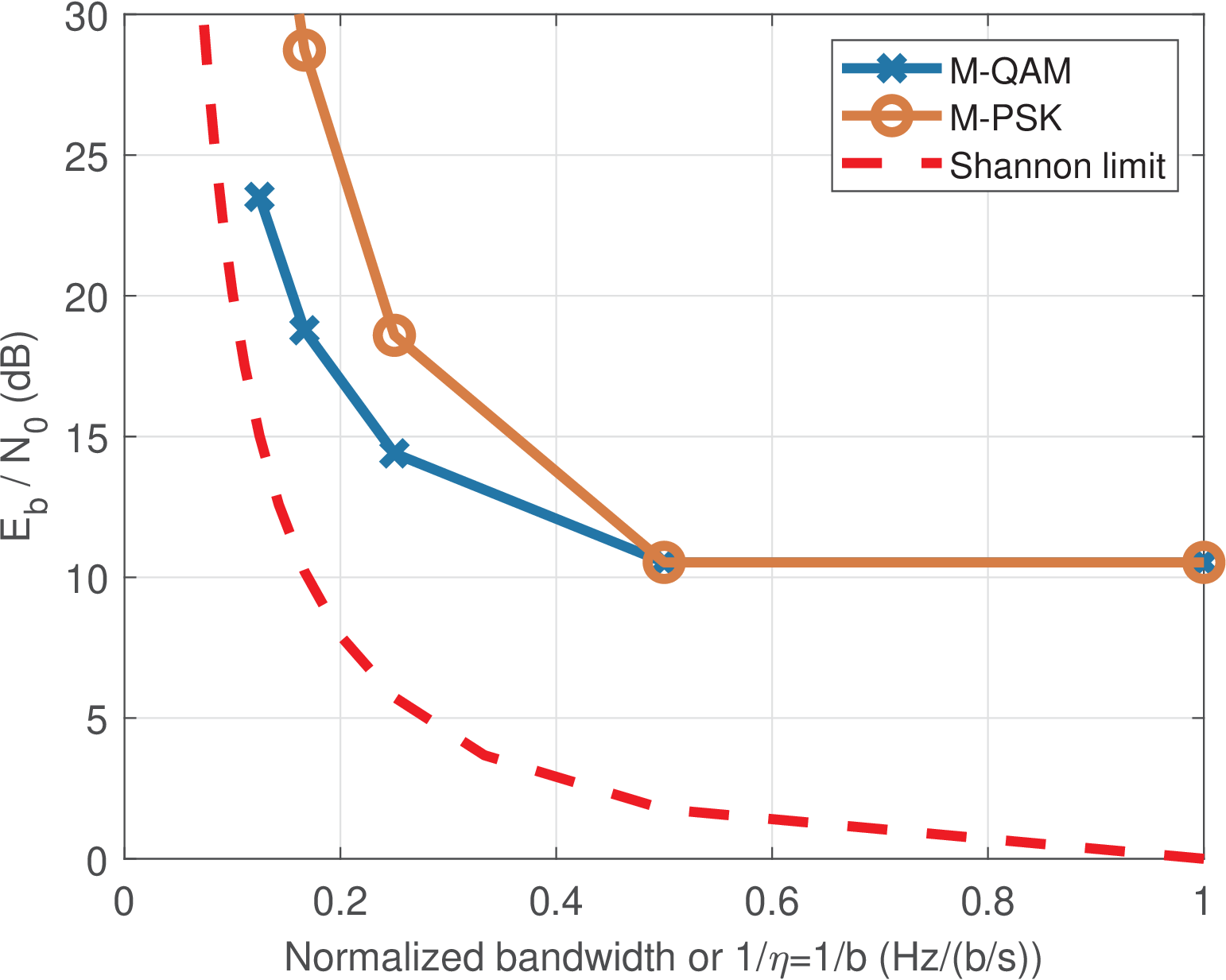
Figure 5.15 is an alternative to Figure 5.14 in which the abscissa is instead of . The value can be interpreted as a normalized bandwidth , which is in this case. Figure 5.15 illustrates the tradeoff between transmitted power and bandwidth. For a given , when increases, less bandwidth is required at the expense of a larger signal power.